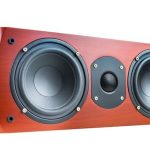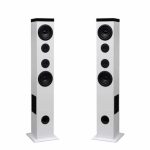Floorstanding speakers, when set right, open up a whole new world of audio entertainment. From including a wide dynamic range to increasing accuracy at all frequencies, these speakers make a room-energizing impact that completely changes your entertainment experience.
One of the biggest benefits of adding floorstanders to your home audio system is a deep and broad sound stage. The speakers effectively separate instruments and voices in your audio and project them well around the listening area. As a result, you enjoy the smooth, dynamic, well-differentiated, and balanced pristine sound.
Everything good comes at a cost. And the cost you undergo to enjoy the top-notch sound output from floor-standing speakers includes proper speaker placement, making good use of sound reflections, sound-enhancing wiring options, and sound imaging.
Floorstanding speaker Placement for best Sound output
High-quality speakers are at the core of any sound system. When you decide to have some floorstanders in your home theater, of course, you are ready to spend a considerable amount of money. But the thing is, buying the best quality speakers is only one part of the journey toward great audio. The other essential part of the work is making sure that the speakers are properly placed.
Generally, tower speakers are placed according to the nature of the listening space. The aim is to disperse them evenly throughout the space while avoiding reflections or feedback that may deteriorate the quality of sound delivered. Stationing speakers at the right places ensures that you get optimal sound performance and the utmost value for your dollars.
1. Useful tips for the Placement of Floorstanding Speakers

You are going to need a tape measure and a calculator. Floorstanders sound best when placed evenly along the length of the room. So, you want to take the time to do a bit of math to determine the right position for each of your speakers based on the shape and size of your room. For more information on how to determine the right positions for your speakers based on the room’s measurements, check out our detailed guide for determining the required number of floorstanding speakers according to room size.
Center the listening position – if you have a surround sound system, the secret to incredible sound delivery is merging the left and right sound at the listening position. So, while you distribute your floorstanders across the room, ensure that each speaker is approximately the same distance from the listening position.
Determine the right Speaker Height – a lot has been written about speaker height and you can guess that this is critical to the performance of tower speakers.
Before you go out shopping for floorstanding speakers, it’s helpful to know how high the speaker should be when installed in your room. This knowledge will help you when choosing speakers so that you do not pick a speaker that is too tall or too short.
Trying to get top-notch sound from a floorstander that is too tall is a headache as there’s little you can do to bring the speaker to the required height. A short speaker can be raised to the desired height by mounting or placing it on a stool. But for a tall speaker, you cannot cut it or dig a hole for it so that the unit becomes shorter. Thus, it’s essential that you think through the speaker height issue before you start the selection process.
No items in front of your speakers – Obstacles distort the projection of sound as it leaves the speaker. Something as ignorable as a stack of DVDs can interfere with audio delivery. There should be nothing standing in the way of your speakers’ delivery.
Minimize rattling – the movement of different drivers making up the floorstanding speaker can cause vibration in the speaker cabinet, especially if the speaker rests on a hard surface. Placing a mat between the speaker and the floor will help to prevent rattling and other disturbances caused by vibration.
Leave a 6-inch space between the speaker and walls. This will minimize the reverberation of sound, which reduces audio quality.
Don’t place speakers next to each other as doing so would create undesired feedback.
Angling your Speakers – For the best sound output, your speakers need to face the listening spot. You may or may not need to tilt the speakers to a specific angle depending on the speaker’s model. Consult the installation manual to know whether or not the model you bought needs angling.
2. Making good use of Sound Reflections

Reflections aren’t necessarily a bad thing in the context of speaker installation.
And, factually speaking, avoiding reflections is an unattainable dream because the sound produced by your speakers will always bounce back as long as there are boundaries in the listening environment. It is what you do with the reflections that matter.
Your target should be positioning your speakers such that any reflections actually enhance the quality of the overall sound.
Different speaker positions influence the existence of sound reflections and the enhancement or limitation of certain frequencies. It’s crucial to understand these influences when making your final decision on where and how to position your floorstanding speakers.
- Speaker placement next to a surface – say on the floor or on a stool next to a wall – lowers the midrange in favor of better bass output.
- Placing a floorstander next to two surfaces – like on the floor adjacent to a wall, or on a stool in a corner – boosts the bass even better than in the above placement.
- For maximum bass output, the speaker is placed on the floor in a corner (next to three surfaces).
Imagine for a second that a speaker is placed at the center of a room, raised on a stand, such that the distances between it and nearing boundaries (floor, ceiling, walls) are equal. This installation option might be hard to imagine, because no one does uses it. Such a placement would be disastrous. All reflections would occur at the same frequency, giving a critically ill-defined bass balance.
The best speaker arrangement for top-notch sound output is where interactions between sound from the speakers and the resultant reflections occur at different frequencies. This way, original sounds, and their reflections are spread evenly across the space and deliver the smoothest bass performance.
In addition to considering reflections, savvy sound installers aim for a naturally balanced midrange. Stereo imaging works magic if your target is to balance the delivery of mid-frequencies.
3. Stereo imaging
Full-range speakers can only achieve proper imaging if they are accurate. In sound reproduction, accuracy creates synchronization, which is essential to facilitating a stable stereo image.
Great stereo imaging dictates that speakers must remain faithful to the audio source in terms of tonal accuracy, and drivers and crossovers should play in perfect unison. You know that a speaker has achieved perfect imaging if the overall sound appears as though it is coming from a flawless soundstage – one with no gaps at all. On the other hand, lack of accuracy makes the soundstage distorted, with different sounds appearing muddied together.
So, what are you supposed to do about stereo imaging?
You can do little about imaging during the installation of your floorstanding speakers. But you can focus your search on speakers made by top brands that have mastered the science and artistry of creating a stereo image.
4. Correct Wiring
Using high-quality, high-conductivity wires helps in many ways, including increasing the efficiency of current transmission, preventing of wiring issues, and enhancing sound output. Choose the best connecting wires and your system will reciprocate by playing your tunes the way you want them.
You’ll need to consider several aspects concerning wiring – the length, thickness, type, and resistance of speaker cables.
Length of Speaker Wire: The determination of what length is appropriate will follow practicality rules; you cannot have the length too low no matter how desirable it is to keep resistance low (shorter lengths imply low resistance, thus less power required).
The gauge of Speaker Wire: The gauge and thickness of the wire you choose also influences the wire’s functioning. These two characteristics are inversely proportional; the thicker the wire, the lower the gauge.
What wire gauge should you choose?
Thick cables (12 or 14 gauge) are recommended for high power applications, long wire runs, and low-impedance speakers (4 or 6 ohms). 16-gauge wire is recommended for shorter runs (50 feet and below) and 8-ohm speakers.
Type of wire: Remember to put a little thought into the type of connecting wire you want to use. There are speaker wires that come with connectors and others that don’t have connectors. Wires with connectors are preferable, but should you find yourself with a wire that doesn’t have connectors, it is strongly recommended to buy banana connectors to avoid the hustles and inefficiencies of bare wire.
Impedance: You might wonder why ohms and impedance are a big deal when it comes to the installation of speakers. Let’s quickly discuss what ohms are and why it is important to consider speaker and wire impedance when making your connections.
Impedance is the property of a speaker that restricts or limits the flow of electric current. It is measured in ohms. Every speaker unit has a fixed impedance. Matching speaker and amplifier impedance correctly ensure that the speakers produce high-quality sound and that the amp doesn’t get blown.
You can calculate the impedance of a speaker if you know the voltage and total current of the speaker. Mathematically, impedance equals voltage (in volts) divided by current (in amperes or I). With knowledge of the speaker’s impedance, you can then select the right length and gauge of your speaker wire to ensure that the impedance of the wire also matches that of the speaker and amplifier.
Wiring an Amplification Options
The decision of which wiring and amping options to use is another critical issue when wiring your floorstanding speakers to get the best quality sound. You can choose to have a single-wired or bi-wired system. Some users even go a step further to bi-amp their speakers.
Single-wiring versus bi-wiring
If you want a single-wired system, you buy single-wired speaker cables – basically a single wire with two cores. The wire transmits a full-range signal between the amp and the speaker.
For a bi-wired system, you’ll need bi-wired speaker cables which have two wires and four cores – two wires connecting to the amp and four to the speaker. Bi-wiring gives the advantage of making sure each driver is well fed. One pair of wires carries higher-frequency signals while the other pair carries mid and low frequencies. This separation of frequencies improves sound output.
Bi-wiring is one of the easiest tweaks as it only requires an additional set of speaker wires. It’s easy to know whether or not your speakers can be bi-wired. Check the connection terminals on the back of the speaker, and if a speaker has four terminals at the back, rather than two, then it can be bi-wired.
Bi-Amplification
Bi-amplification is a technique that entails using one amplifier for low frequencies and another for middle and higher frequencies. You connect a bi-amping wire (it has four wires, with each wire having its own insulated conductors) both on the amp end and the speaker end. The technique allows you to take advantage of each amplifier’s strengths in its interactions with the speakers in the audio system. However, you can only utilize bi-amplification for systems with two separate power amps.
If you have a higher-end system, bi-amping is a clever hack that can significantly improve the sound quality of your speakers.
Key points on wiring Floorstanding Speakers for the Best Sound Output
- Keep the phase – each connecting wire has a positive and a negative conductor. Keeping the phase is simply connecting these conductors correctly – the positive conductor from the amp connects to the positive of the speaker, and the negative conductor connects to the negative end of either equipment. Connecting the conductors out of phase deteriorates the sound quality and immensely affects the soundstage.
- Termination – Most tower speakers accommodate banana plugs, BFAs, and spades so you will do great finding speaker wires with any of these connectors. BFAs and banana plugs are inserted into the driver’s outlets while spades hug binding posts.
- Tightwire connections – Wiring speakers tightly ensures that the speaker and other equipment in the system give out their absolute best. Tightness promotes the continuity of transmissions between the speaker and other parts. Also, tight connections last many years.
- Wire Length – There are many factors that influence the required length of speaker wire to use. Longer cables are associated with higher resistance and lower sound quality. Thus, it’s crucial to use the smallest but practical length of speaker cable.
With these guiding tips, the top-notch sound output from your floorstanding speakers is guaranteed. Remember that the journey starts from a clever selection of speakers with perfect stereo imaging, and buying the right wires for seamless connections. Then, the knowledge you’ve gathered on the placement of floorstanding speakers will help to ensure that the speakers are installed to deliver the best quality sound.
If the process sounds overwhelming, it’s advisable to consult a professional sound installer. You’d better spend a few extra dollars on professional installation than make a DIY attempt that will result in sub-optimal sound performance.
Michael Evanchuk is a San Francisco-based sound engineer with 20 years’ experience installing, troubleshooting, and repairing commercial, automotive, and household sound equipment. Evanchuk owns an auto stereo center, where he offers highly competitive car audio installation and repair services. He has written dozens of articles on different sound engineering topics, all of which have been published in leading journals, blogs, and websites.





